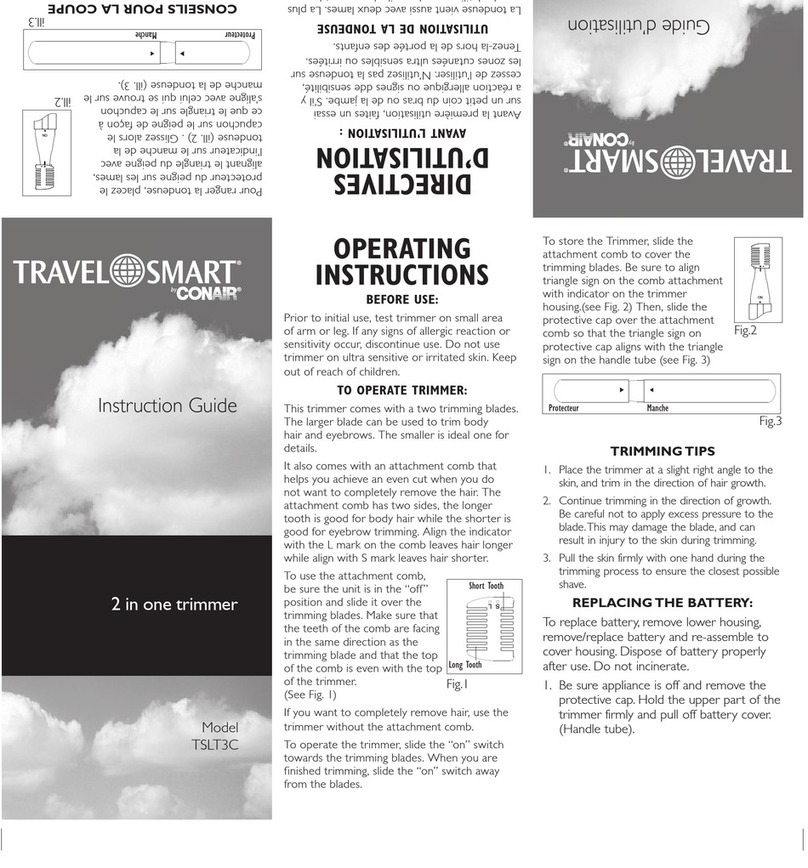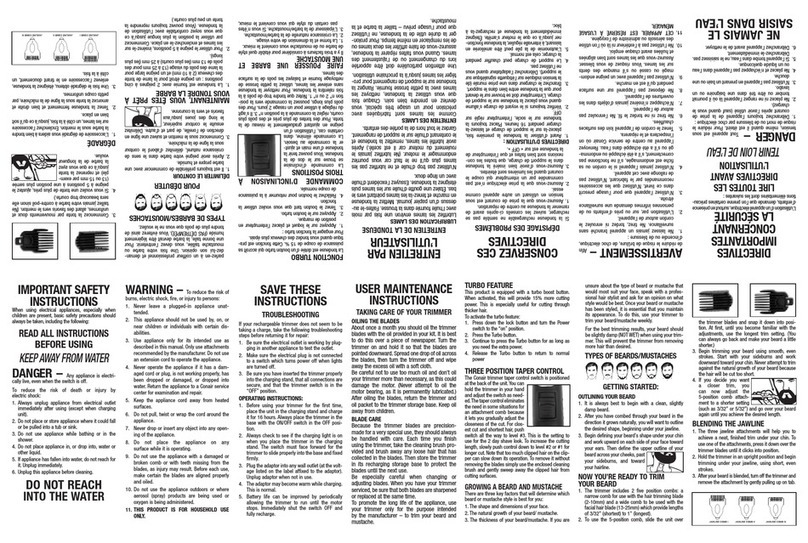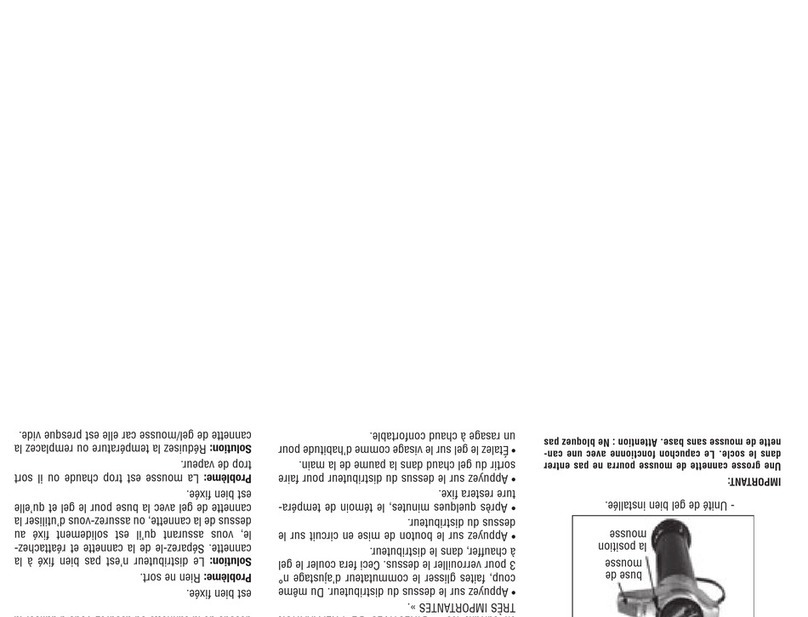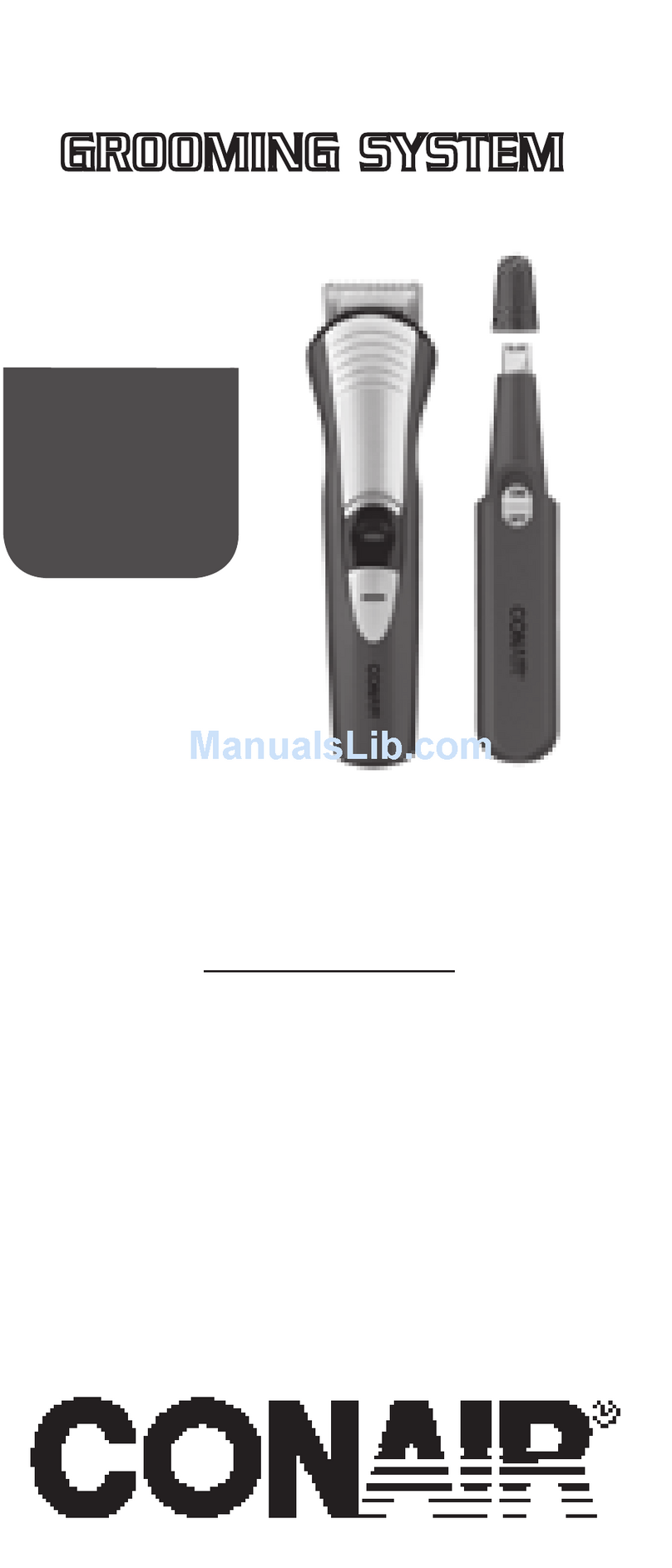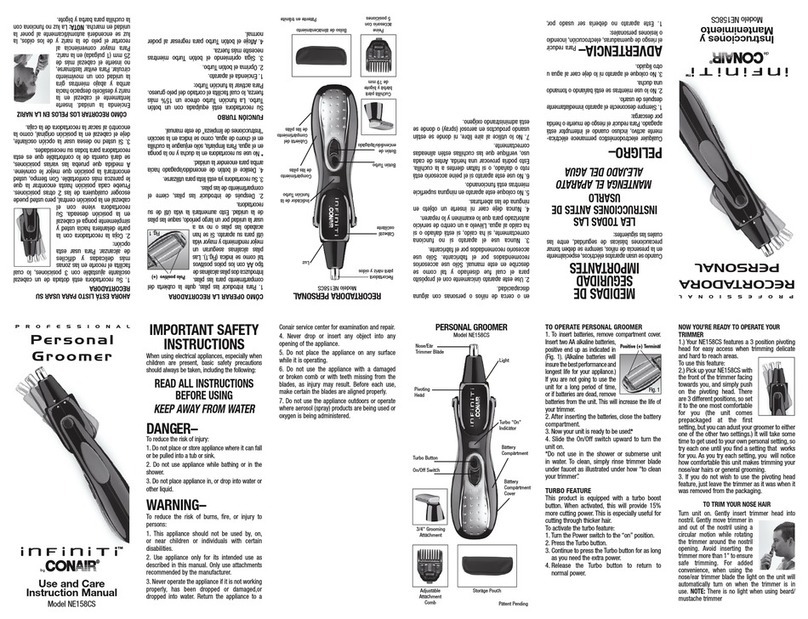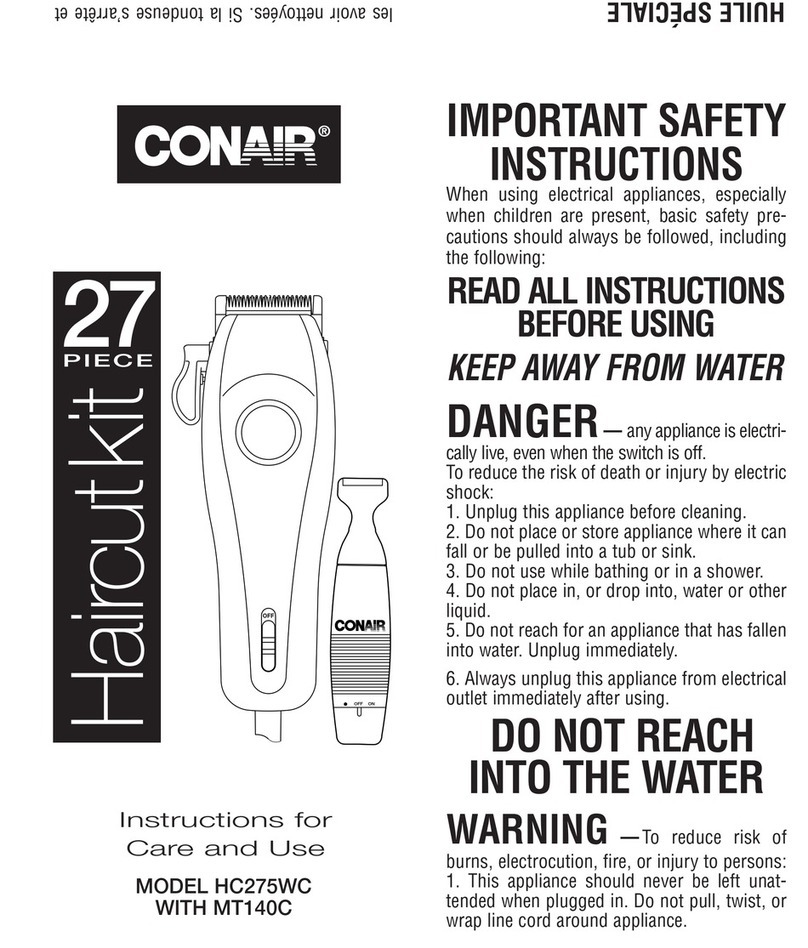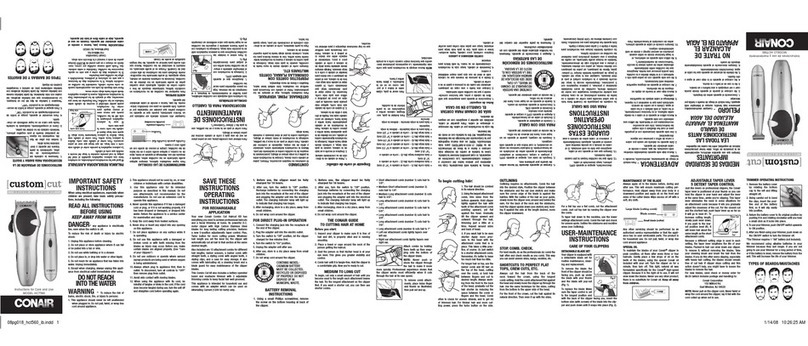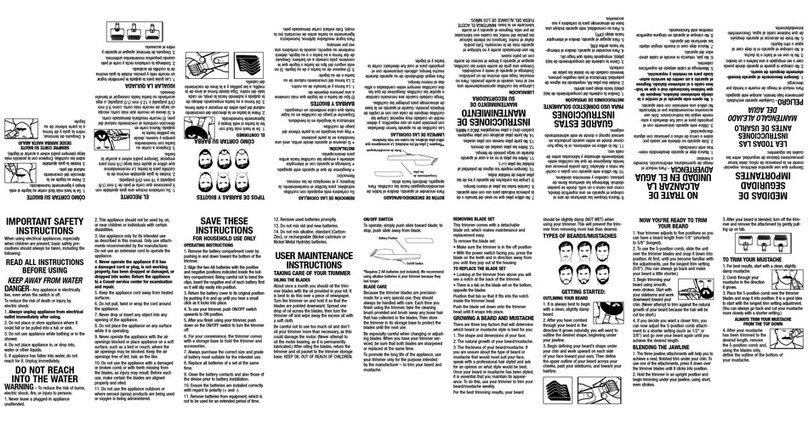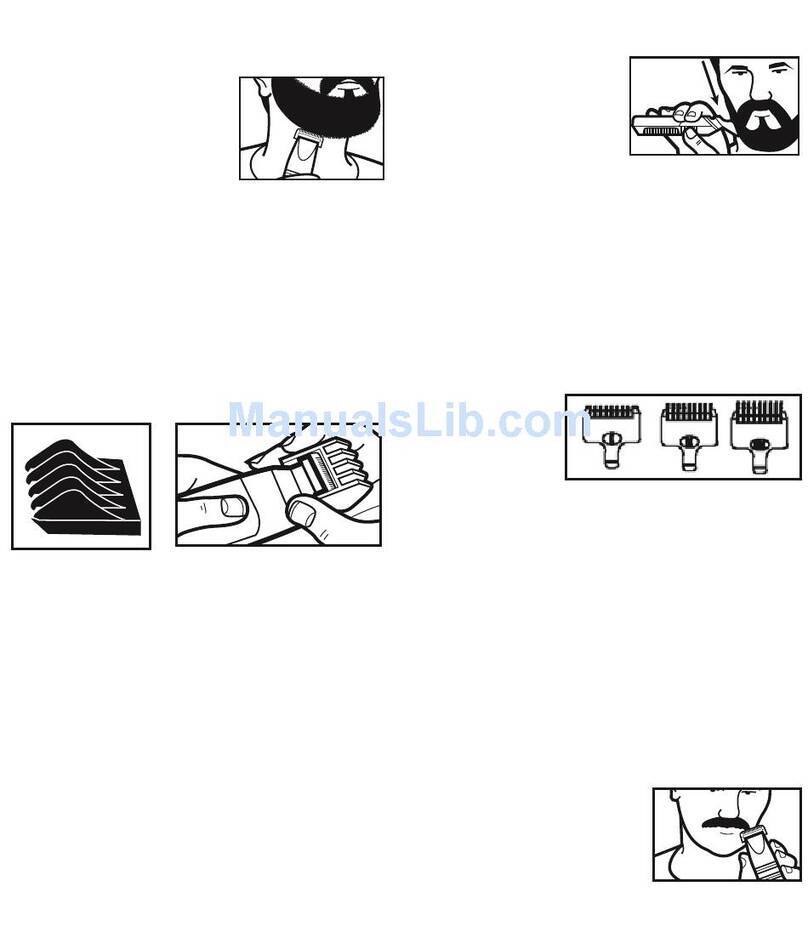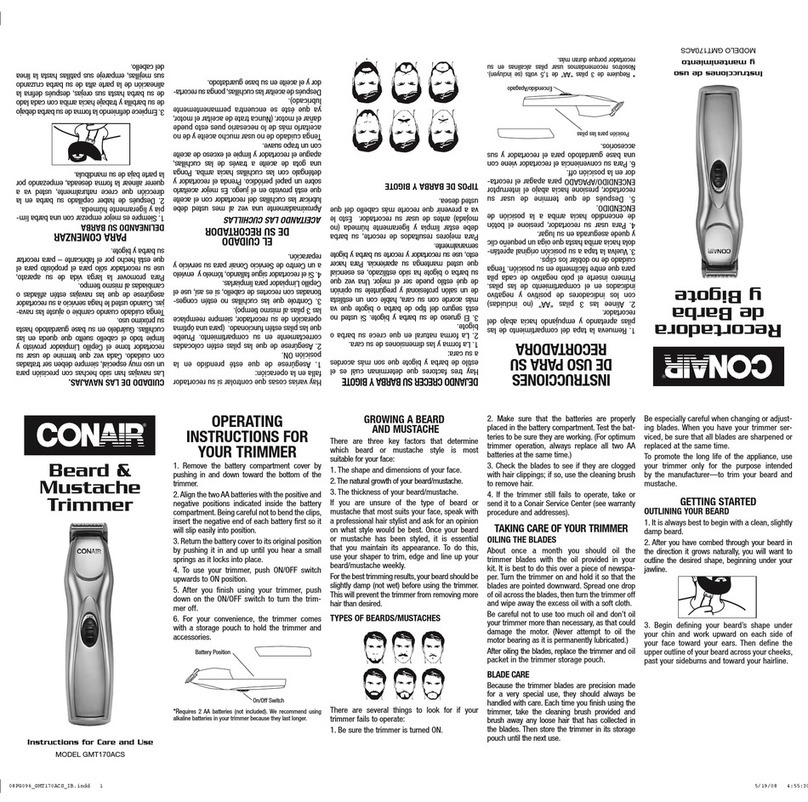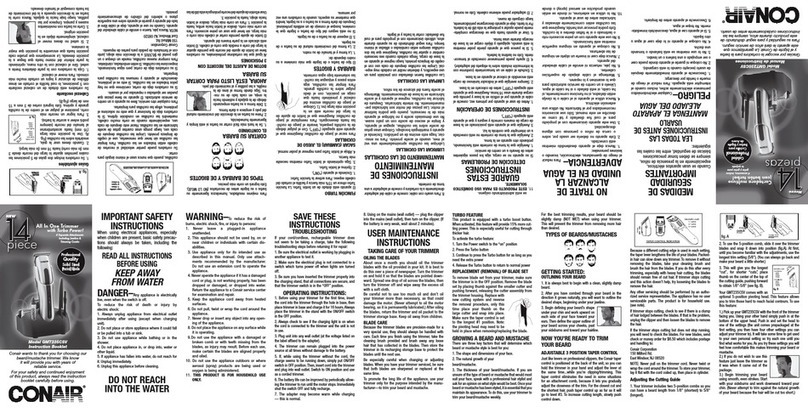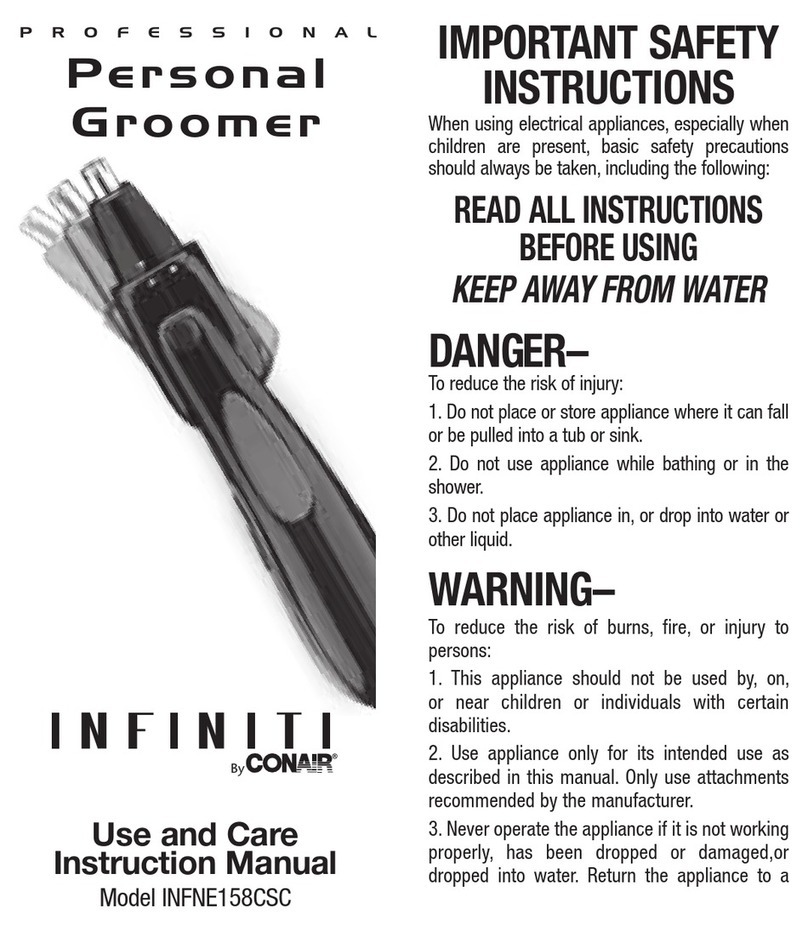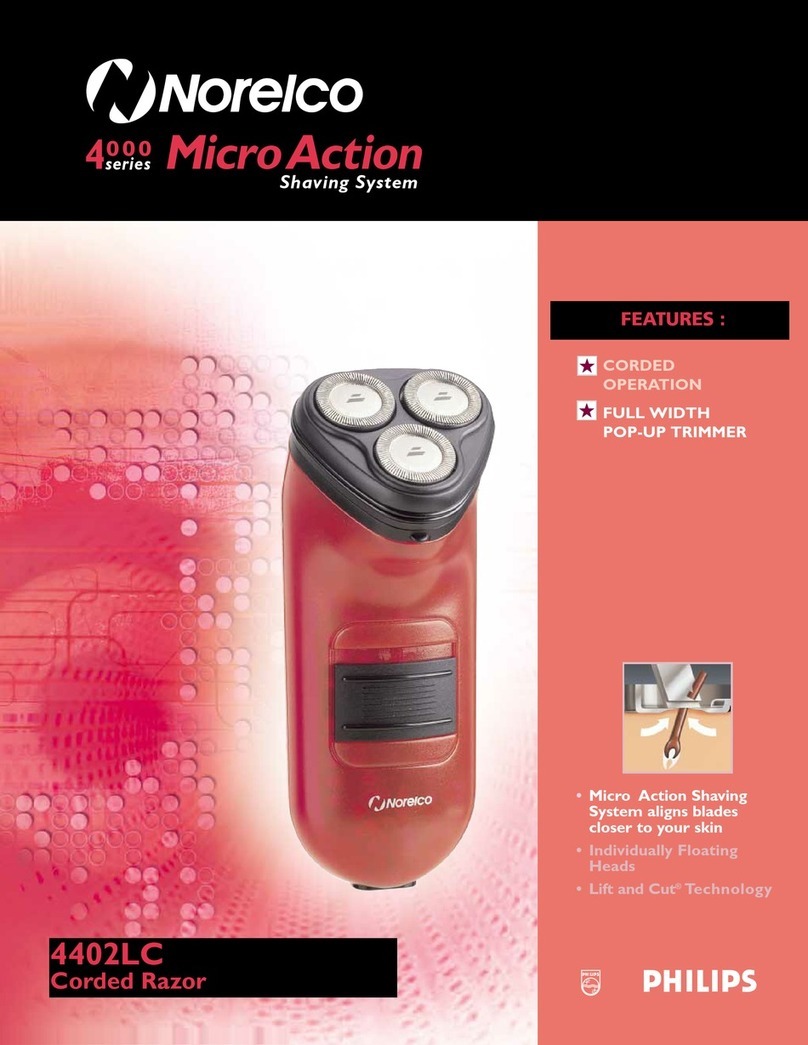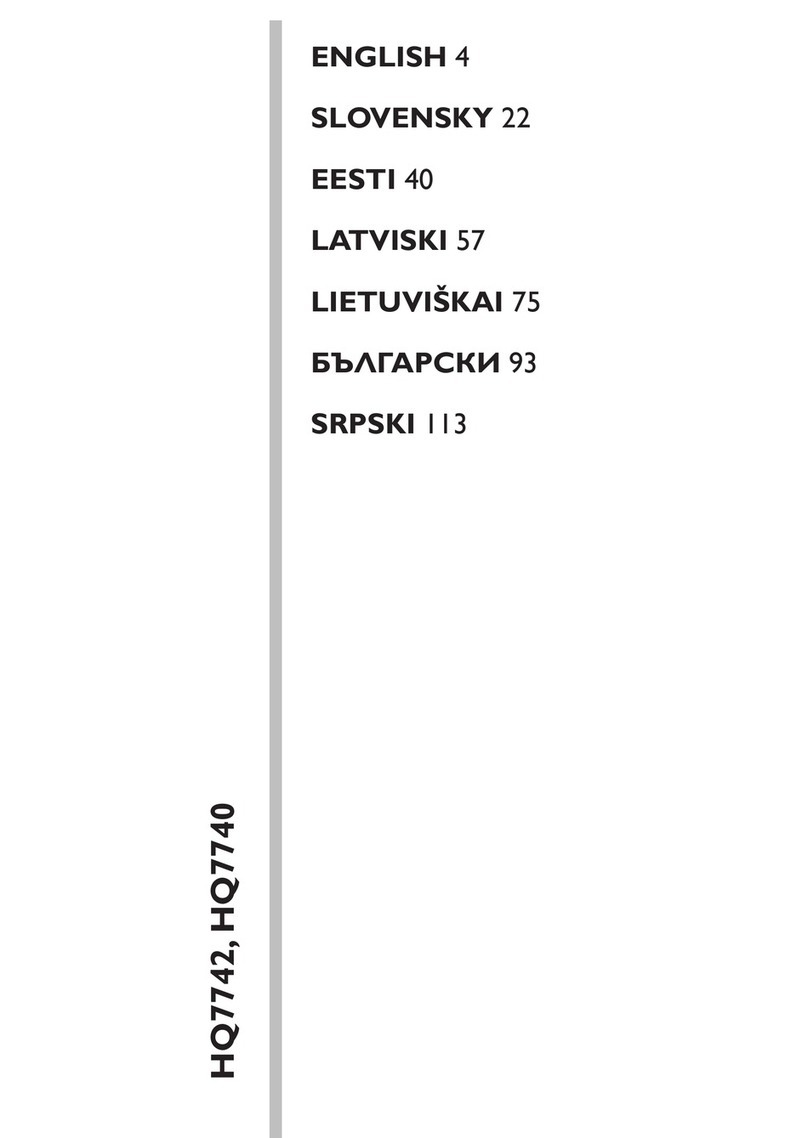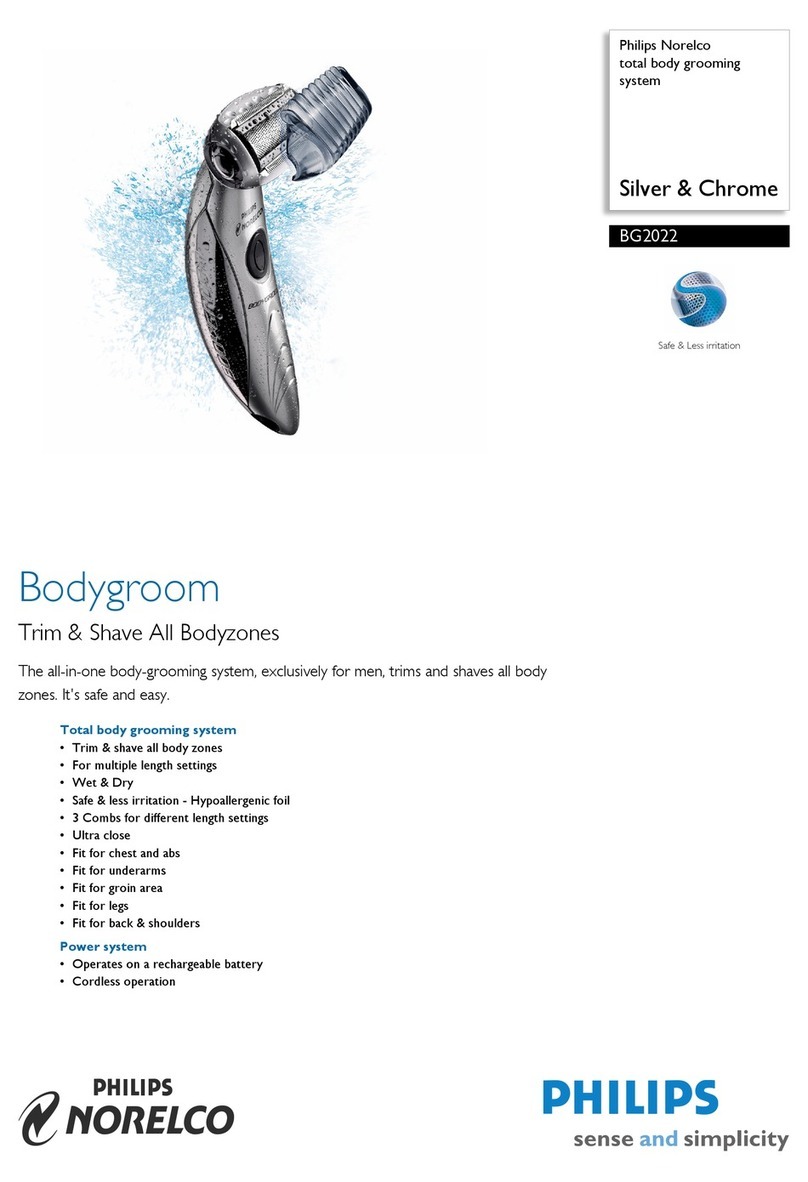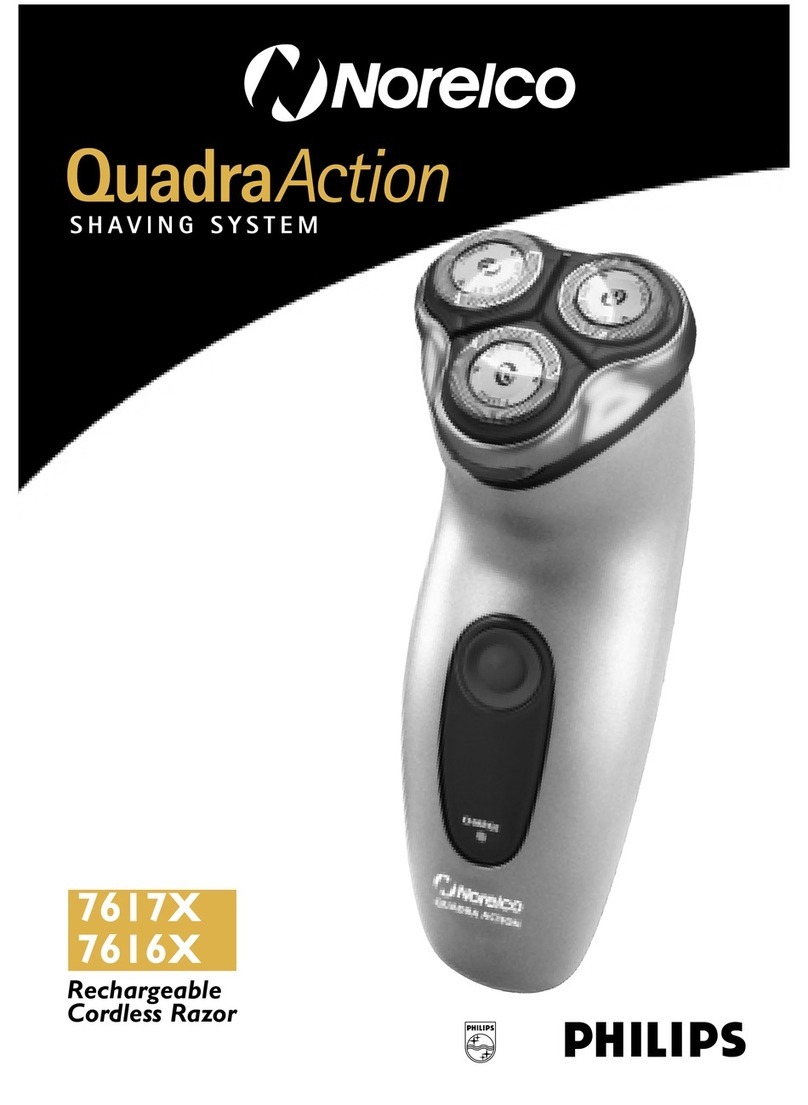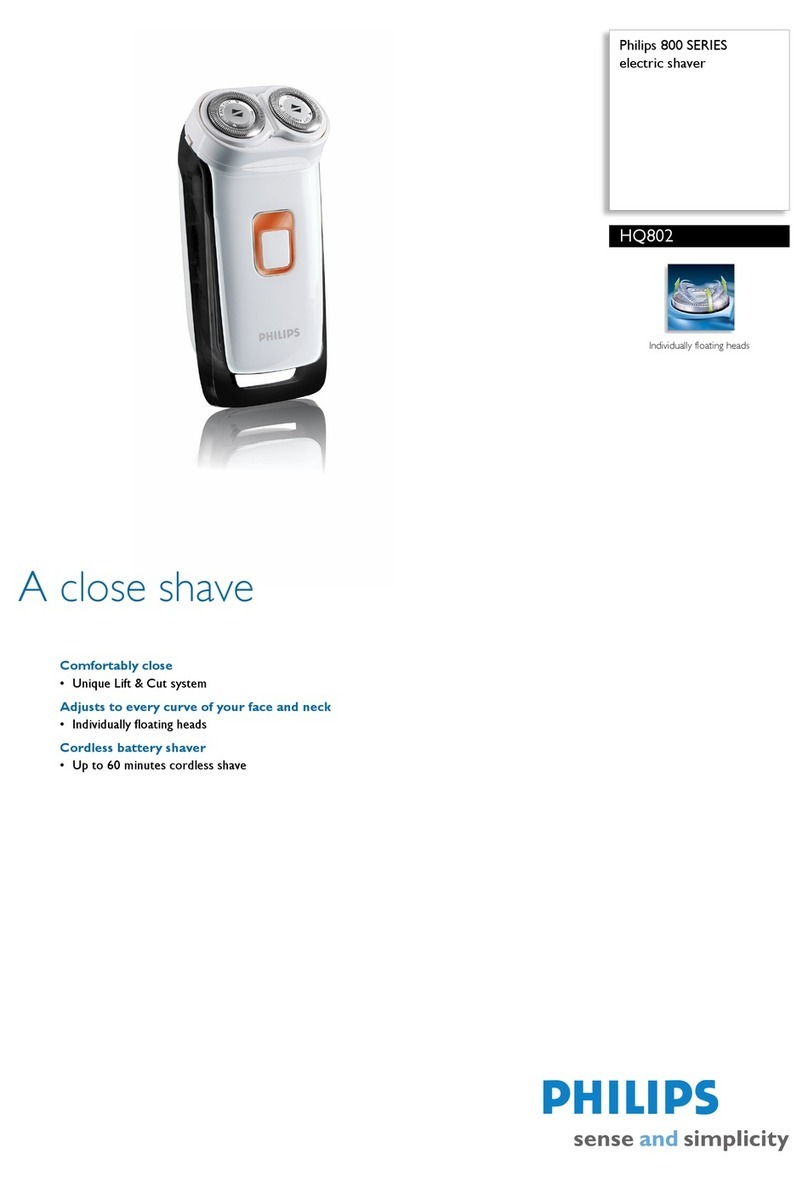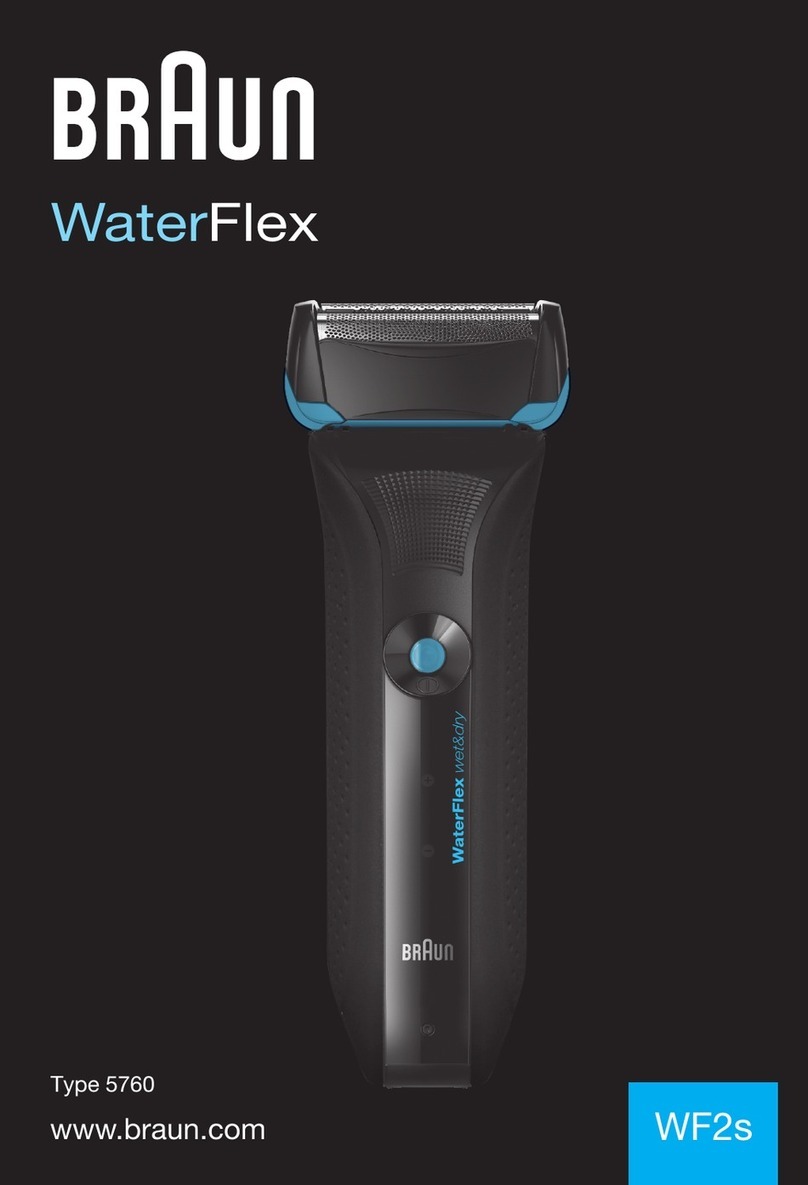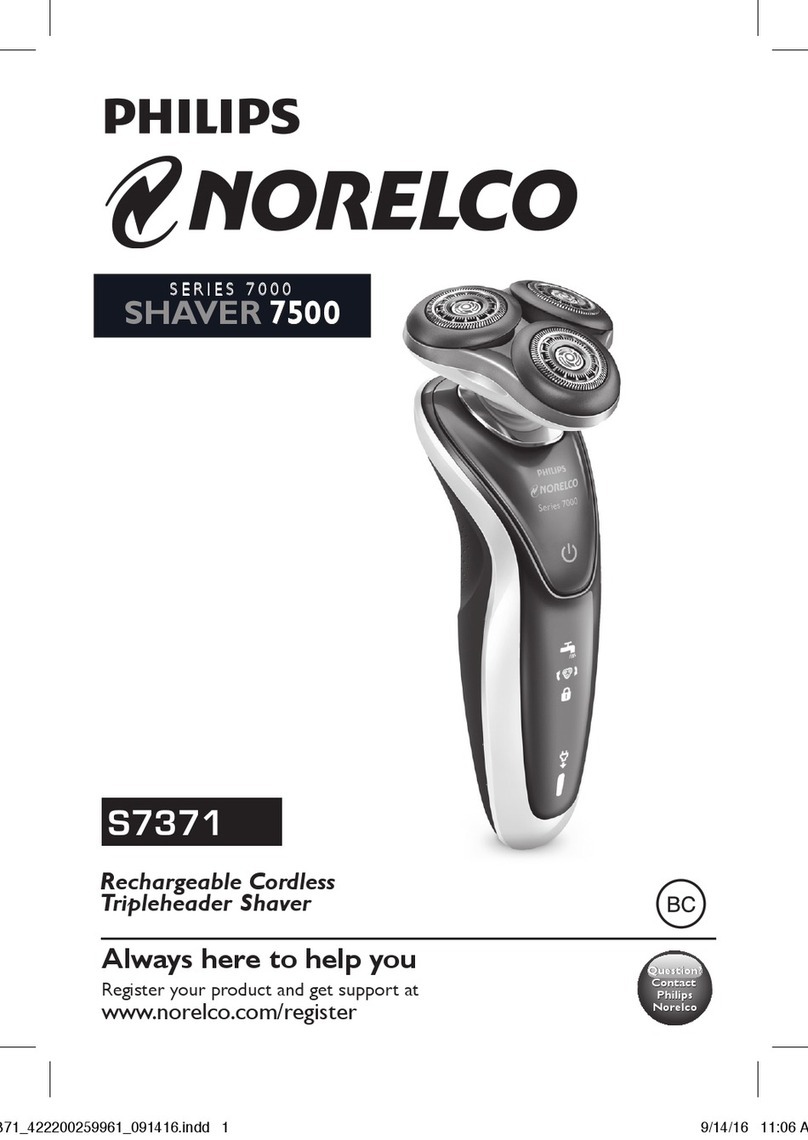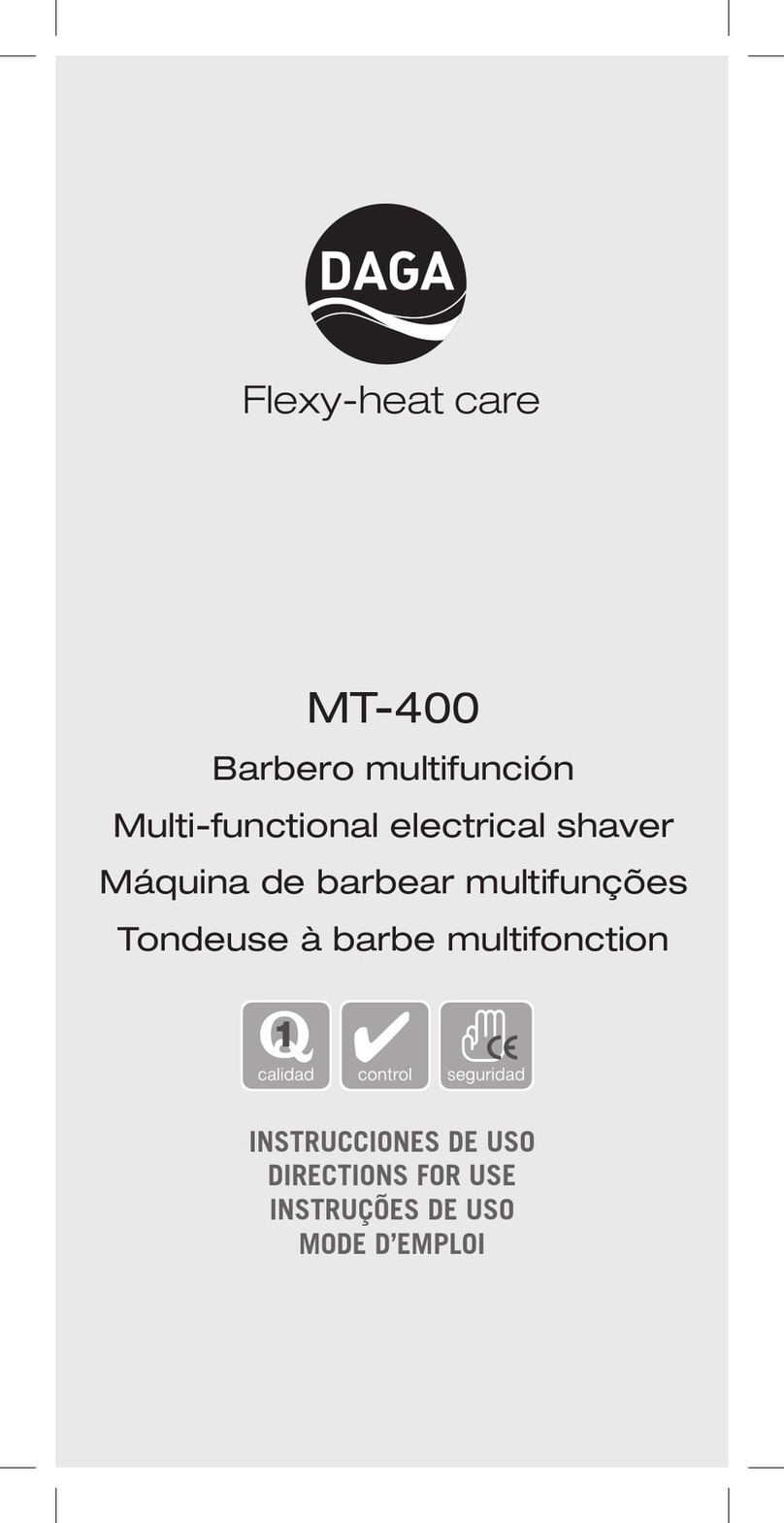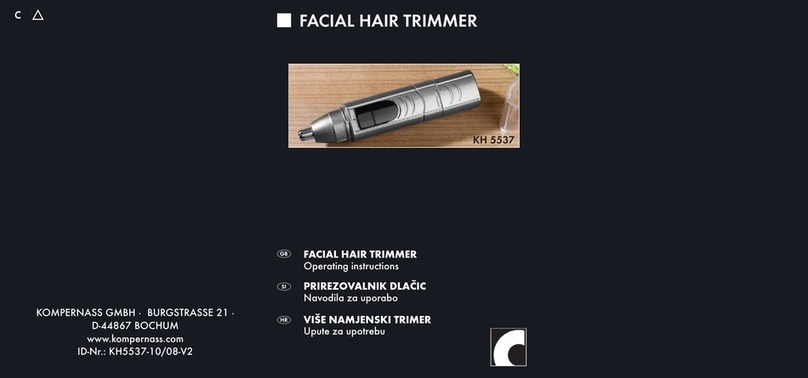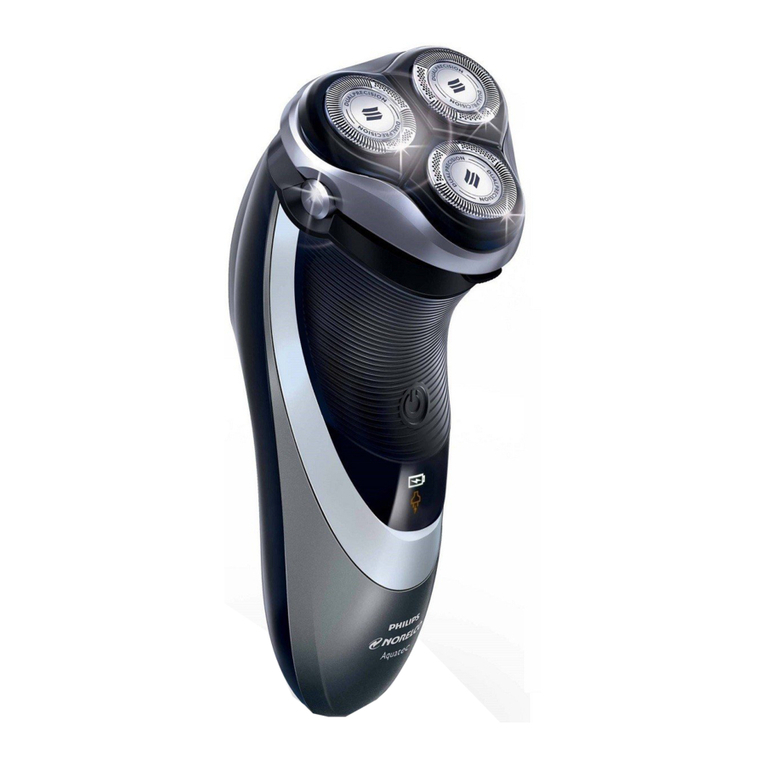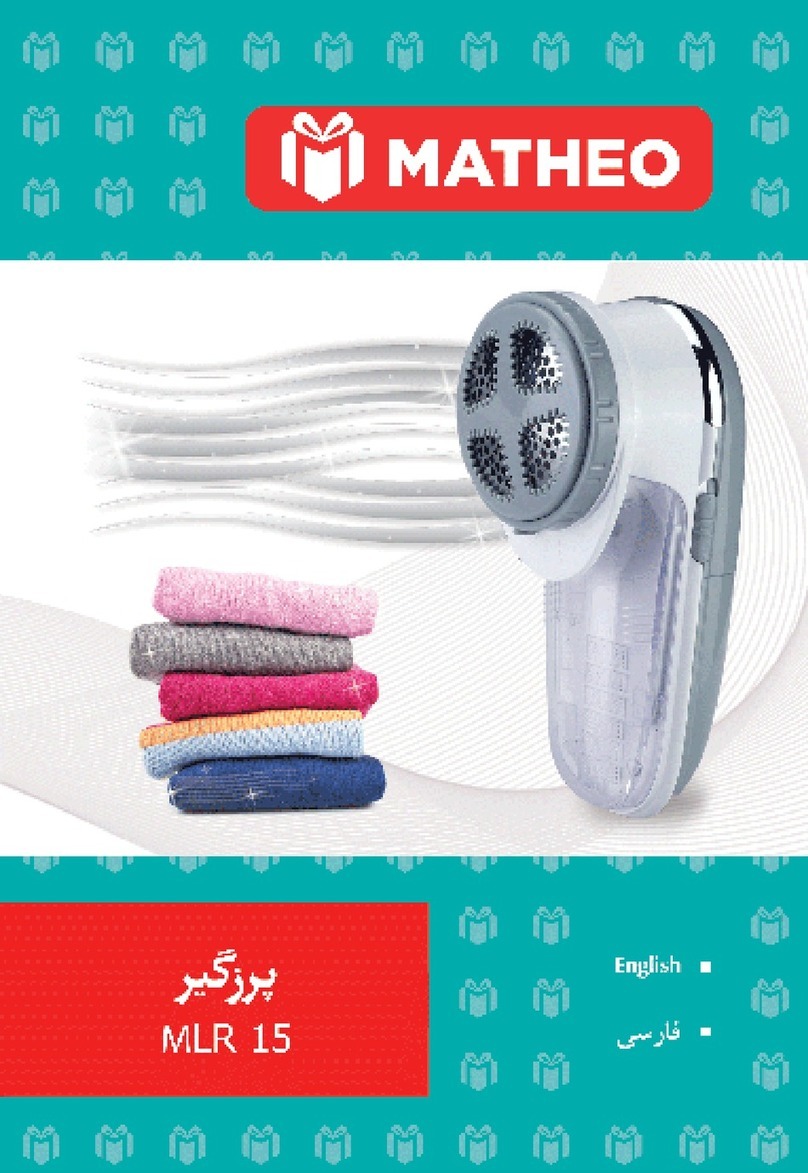IMPORTANT SAFETY
INSTRUCTIONS
When using electrical appliances, especially
when children are present, basic safety precau-
tions should always be taken, including the
following:
READ ALL INSTRUCTIONS
BEFORE USING
KEEP AWAY FROM
WATER
DANGER– any appliance is electrically
live, even when the switch is off.
To reduce the risk of death or injury by electric
shock:
1. Always unplug appliance from electrical
outlet immediately after using (except when
charging unit).
2. Do not place or store appliance where it
could fall or be pulled into a tub or sink.
3. Do not use appliance while bathing or in the
shower.
4. Do not place appliance in, or drop into, water
or other liquid.
5. If appliance has fallen into water, do not reach
for it. Unplug immediately.
6. Unplug this appliance before cleaning.
DO NOT REACH
INTO THE WATER
WARNING– To reduce the risk of burns,
electric shock, fire, or injury to persons:
1. Never leave a plugged-in appliance unat-
tended.
2. Close supervision is necessary when this
appliance is used by, on, or near children or
individuals with certain disabilities.
3. Use appliance only for its intended use as
described in this manual. Only use attach-
ments recommended by the manufacturer.
Do not use an extension cord to operate the
appliance.
4. Never operate the appliance if it has a dam-
aged cord or plug, is not working properly, has
been dropped or damaged, or dropped into
water.Return the appliance to a Conair service
centre for examination and repair.
5. Keep the appliance cord away from heated
surfaces.
6. Do not pull, twist or wrap the cord around the
appliance.
7. Never drop or insert any object into any open-
ing of the appliance.
8. Do not place the appliance on any surface
while it is operating.
9. Do not use the appliance with a damaged or
broken comb or with teeth missing from the
blades, as injury may result. Before each use,
make certain the blades are aligned properly
and oiled.
10. Do not use the appliance outdoors or where
aerosol (spray) products are being used or
oxygen is being administered.
11.THIS PRODUCT IS FOR HOUSEHOLD USE
ONLY.
SAVE THESE
INSTRUCTIONS
FOR HOUSEHOLD USE ONLY
TROUBLESHOOTING
If your rechargeable trimmer does not seem to be
taking a charge, take the following troubleshoot-
ing steps before returning it for repair:
1. Be sure the electrical outlet is working by plug-
ging in another appliance to test the outlet.
2. Make sure the electrical plug is not connected
to a switch which turns power off when lights
are turned off.
3. Be sure you have inserted the adaptor cord
into trimmer, that all connections are secure,
and that the trimmer switch is in the “OFF”
position.
OPERATING INSTRUCTIONS:
1. Before using your trimmer for the first time,
place the unit in the charging stand and charge
it for 16 hours. Always place the trimmer in
the base with the ON/OFF switch in the OFF
position.
2. Always check to see if the charging light is on
when you place the trimmer in the charging
stand. The switch must face forward for the
trimmer to slide properly into the base.
3. Plug the charger into any wall outlet (at the
voltage listed on the label affixed to the charg-
ing stand).
4. The charging stand can remain plugged into
the power source at all times without damage
to the battery.
5. To ensure that maximum charge is always
available, leave your trimmer in the charging
stand at all times. This will not overcharge or
damage the trimmer.
6. The charging stand may become warm while
charging. This is normal.
Preserving the batteries:
In order to maintain the optimum capacity of
the rechargeable batteries, the unit should be
recharged for 16 hours every 3 months approxi-
mately.
USER MAINTENANCE
INSTRUCTIONS
TAKING CARE OF YOUR TRIMMER
OILING THE BLADES
About once a month you should oil the trimmer
blades with the oil provided in your kit. It is best
to do this over a piece of newspaper. Turn the
trimmer on and hold it so that the blades are
pointed downward. Spread one drop of oil across
the blades, then turn the trimmer off and wipe
away the excess oil with a soft cloth.
Be careful not to use too much oil and don’t oil
your trimmer more than necessary, as this could
damage the motor. (Never attempt to oil the
motor bearing as it is permanently lubricated.)
After oiling the blades, return the trimmer and oil
packet to the trimmer storage base.
BLADE CARE
Because the trimmer blades are precision-made
for a very special use, they should always be
handled with care. Each time you finish using the
trimmer, take the cleaning brush provided and
brush away any loose hair that has collected in
the blades. Then store the trimmer in its recharg-
ing storage base to protect the blades until the
next use.
Be especially careful when changing or adjusting
blades. When you have your trimmer serviced, be
sure that both blades are sharpened or replaced
at the same time.
To promote the long life of the appliance, use
your trimmer only for the purpose intended by
the manufacturer-to trim your beard and mus-
tache.
TURBO FEATURE
This product is equipped with a turbo boost but-
ton. When activated, this will provide 15% more
cutting power. This is especially useful for cutting
through thicker hair.
To activate the turbo feature:
1. Press down the lock button and turn the Power
switch to the “on” position.
2. Press the Turbo button.
3. Continue to press the Turbo button for as long
as you need the extra power.
4. Release the Turbo button to return to normal
power.
GROWING A BEARD AND MUSTACHE
There are three key factors that will determine
which beard or mustache style is best for you:
1. The shape and dimensions of your face.
2. The natural growth of your beard/mustache.
3. The thickness of your beard/mustache. If you
are unsure of the type of beard or mustache
that would most suit your face, speak with a
professional hair stylist and ask for an opinion
on what style would be best. Once your beard
or mustache has been styled, it is essential that
you maintain its appearance. To do this, use your
trimmer to trim your beard/mustache weekly.
For the best trimming results, your beard should
be slightly damp (NOT WET) when using your
trimmer. This will prevent the trimmer from
removing more hair than desired.
TYPES OF BEARD/ MUSTACHES
GETTING STARTED:
Outlining Your Beard
1. It is always best to begin
with a clean, slightly damp
beard.
2. After you have combed through your beard in
the direction it grows naturally, you will want to
outline the desired shape, beginning under your
jawline.
3. Begin defining your beard’s shape under your
chin and work upward on each side of your face
toward your ears. Then define the upper outline
of your beard across your cheeks, past your side-
burns and toward your hairline.
Now You’re Ready to Trim Your Beard
1. Your trimmer adjusts to five positions so you
can have a beard length from 1/8” (shortest) to
5/8” (longest).
2. To use the 5-position comb, slide the unit over
the trimmer blades and snap it down into posi-
tion. At first, until you become familiar with the
adjustments, use the longest trim setting (5/8”).
(You can always go back and make your beard a
little shorter.)
3. Begin trimming your beard using smooth, even
strokes. Start with your sideburns and work
downward toward your chin.
(Never attempt to trim against the natural growth of
your beard because the hair will be cut too short.)
4. If you decide you want a closer trim, you can
now adjust the 5-position comb attachment to a
shorter setting (such as
1/2” or 3/8”) and go over
your beard again until
you achieve the desired
length.
BLENDING THE JAWLINE
1. The Three Jawline Attachments will help you to
achieve a neat, finished trim under your chin. To
use the attachments, press it down over the trim-
merblades until it clicks into position.
2. Hold the trimmer in an upright position and
begin trimming under your jawline, using short,
even strokes.
3. After your beard is blended, turn off the trimmer
and remove the attachment by gently pulling up
on tab.
DIRECTIVES
IMPORTANTES
CONCERNANT LA
SÉCURITÉ
L’utilisation d’un appareil électrique, surtout en
présence d’enfants, demande que l’on prenne
certaines précautions élémentaires dont les
suivantes :
LIRE TOUTES LES
DIRECTIVES AVANT
L’UTILISATION
TENIR LOIN DE L’EAU
DANGER– Tout appareil est sous ten-
sion, même quand il est éteint.
Pour réduire le risque de mort ou de blessure
par choc électrique :
1. Débranchez toujours l’appareil de la prise de
courant après l’avoir utilisé (sauf quand vous
le chargez).
2. Ne placez ni ne rangez l’appareil là où il pour-
rait tomber ou être tiré dans une baignoire ou
un lavabo.
3. N’utilisez pas l’appareil en prenant un bain
ou une douche.
4. Ne placez et n’échappez pas l’appareil dans
l’eau ou un liquide quelconque.
5. Si l’appareil tombe dans l’eau, ne le
saisissez pas. Débranchez-le immédiate-
ment.
6. Débranchez l’appareil avant de le nettoyer.
NE PAS LE SAISIR
DANS L’EAU
ADVERTISSEMENT – Afin de
réduire le risque de brûlure, de choc électrique,
d’incendie ou de blessure :
1. Ne laissez jamais un appareil branché sans
surveillance. Ne tirez, tordez ni enroulez le cordon
autour de l’appareil.
2. L’utilisation par, sur ou près d’enfants ou de
personnes infirmes demande une surveillance
étroite.
3. N’utilisez l’appareil que pour l’usage prescrit
dans ce livret. N’utilisez que les accessoires
recommandés par le fabricant. N’utilisez pas de
rallonge avec cet appareil.
4. N’utilisez jamais l’appareil si le cordon ou
sa fiche est endommagée, s’il ne fonctionne
pas correctement, s’il a été échappé ou endom-
magé ou s’il a été échappé dans l’eau. Renvoyez
l’appareil au centre de service Conair où on
l’inspectera et le réparera.
5. Tenez le cordon de l’appareil loin des surfaces
chauffées.
6. N’échappez n’insérez jamais d’objets dans les
ouvertures de l’appareil.
7. N’utilisez pas l’appareil à l’extérieur ni près
de produits aérosol (atomiseurs) ou là où l’on
administre de l’oxygène.
8. Ne déposez pas l’appareil sur une surface
pendant qu’il est en marche.
9. N’utilisez pas l’appareil avec un peigne
endommagé ou cassé ou s’il manque des dents
sur les lames. Vous risquez de vous blesser.
Assurez-vous que les lames sont bien alignées
avant chaque emploi.
10. Ne l’utilisez pas à l’extérieur ni là où l’on
utilise des aérosols ou administre de l’oxygène.
11.CE PRODUIT EST RÉSERVÉ À L’USAGE
MÉNAGER.
CONSERVEZ CES
DIRECTIVES
DÉPISTAGE DES PROBLÈMES
Si la tondeuse rechargeable ne semble pas se
recharger, suivez les conseils ci-après avant de
ramener la tondeuse au centre de réparatiion.
1. Assurez-vous que la prise de courant est sous
tension en utilisant un autre appareil comme
essai.
2. Assurez-vous que la prise électrique n’est pas
commandée par un interrupteur qui coupe le
courant quand les lumières sont éteintes.
3. Assurez-vous d’avoir bien inséré la tondeuse
dans le support de charge, que toutes les
connexions sont bien faites et que l’interrupteur
de la tondeuse est sur. ‹‹ OFF ››.
DIRECTIVES D’UTILISATION :
1. Avant d’utiliser la tondeuse la première fois,
placez-la sur le support de charge et laissez-la
charger pendant 16 heures. Placez toujours la
tondeuse sur le socle, l’interrupteur réglé sur
OFF.
2. Vérifiez toujours si le voyant de charge s’allume
quand vous placez la tondeuse sur le support
de charge. L’interrupteur doit se trouver sur le
devant pour que la tondeuse entre bien dans le
support.
3. Branchez le chargeur dans une prise murale
(de la tension indiquée sur l’étiquette signalé-
tique sur le support).
4. Le support de charge peut être laissé branché
dans la prise en tout temps sans que cela
endommage la pile.
5. Pour vous assurer d’une charge maximale en
tout temps, laissez toujours la tondeuse dans
le support de charge. La tondeuse ne peut pas
se surcharger ni s’endommager ainsi.
6. Le support de charge peut chauffer pendant la
charge; cela est normal.
Conservation des piles :
Afin de maintenir la capacité optimale des piles
rechargeables, l'appareil devrait être rechargé pen-
dant 16 heures tous les 3 mois environ.
ENTRETIEN PAR
L’UTILISATEUR
ENTRETIEN DE LA TONDEUSE
LUBRIFICATION DES LAMES
Lubrifiez les lames environ une fois par mois
avec l’huile fournie dans la trousse. Faites-le au-
dessus d’un papier journal. Mettez la tondeuse
en marche et tenez-la les lames pointant vers le
bas. Étalez une goutte d’huile sur les lames puis
éteignez la tondeuse. Essuyez l’excédent d’huile
avec un linge doux.
N’utilisez pas trop d’huile et ne lubrifiez pas
les lames plus qu’il ne le faut car vous pourriez
endommager le moteur. (Ne lubrifiez jamais le
roulement du moteur car il est scellé.)
Après avoir lubrifié les lames, remettez la ton-
deuse et le contenant d’huile sur le support de
rangement.
ENTRETIEN DES LAMES
Comme les lames sont fabriquées avec préci-
sion pour un usage très spécial, vous devriez en
prendre bien soin. Chaque fois que vous utilisez
la tondeuse, nettoyez les lames avec la petite
brosse fournie. Rangez la tondeuse sur le support
de rangement pour protéger les lames jusqu’à la
prochaine utilisation.
Une attention particulière doit être apportée lors
du changement ou de l’ajustement des lames.
Quand vous faites réparer la tondeuse, assurez-
vous de faire affûter les deux lames ou de les
remplacer en même temps. Pour prolonger la
durée utile de la tondeuse, ne l’utilisez que pour
l’usage prévu - tailler la barbe et la moustache.
FONCTION TURBO
La tondeuse est dotée d’un bouton turbo qui
accroît sa puissance de coupe de 15 %. Cette
fonction est pratique quand vous tondez des
cheveux plus épais.
Pour engager la fonction turbo :
1. Appuyez sur le loquet et placez l’interrupteur
en position de marque.
2. Appuyez sur le bouton turbo.
3. Tenez le bouton tant que vous voulez utiliser
la fonction
4. Relàchez le bouton pour retourner à la puis-
sance de coupe normale.
FAIRE POUSSER UNE BARBE ET UNE
MOUSTACHE
Il y a trois facteurs à considérer pour établir quel
style de barbe ou de moustache vous convient
le mieux.
1. La forme et la dimension de votre visage.
2. La croissance naturelle de la barbe/mous-
tache.
3. L’épaisseur de la barbe/moustache. Si vous
n’êtes pas certain du style qui vous convient le
mieux, parlez-en à un coiffeur professionnel et
demandez-lui son opinion. Une fois votre barbe
ou moustache taillée, vous devez l’entretenir.
Pour une bonne taile, la barbe devrait être
légèrement humide (PAS DÉTREMPÉE). Vous
éviterez ainsi de tondre plus de poils que vous
ne le vouliez.
TYPES DE BARBES/MOUSTACHES
POUR DÉBUTER
DÉLIMITER LE CONTOUR
1. Il est toujours préférable de
commencer avec une barbe
propre et humide.
2. Après avoir peigné votre
barbe dans le sens de crois-
sance naturel, délimtier d’abord le contour sous
la ligne de la mâchoire.
3. Commencez sous le menton et suivez une
ligne en direction de l’oreille, de part et d’autre.
Délimtier ensuite le contour supérieur, le long des
joues jusqu’aux favoris et vers la couronne.
MAINTENANT, VOUS ÊTES PRÊT À TONDRE
VOTRE BARBE
1. La tondeuse s’ajuste selon cinq positions pour
donner une barbe de 1/8 po (le plus court) à 5/8
po (le plus long).
2. Pour utiliser le peigne à 5 positions, insérez-
le sur les lames et enclenchez-le en place.
Commencez par utiliser la position la plus longue
(5/8 po) jusqu’à ce que vous soyez confortable
avec l’utilisation de la tondeuse. (Vous pouvez
toujours reprendre la tonte un peu plus courte.)
3. Commencez la tonte par mouvements doux et
uniformes, allant des favoris vers le menton.
(Ne taillez jamais votre barbe à contre-poil sinon
elle sera beaucoup trop courte.)
(Never attempt to trim against the natural growth of
your beard because the hair will be cut too short.)
4. Si vous voulez une
tonte de plus près, ajustez
le peigne à 5 positions à
une position plus ser-
rée (1/2 po ou 3/8 po par
exemple) et reprenez la tonte jusqu’à ce que vous
ayez la barbe de la longueur voulue.
DÉGRADÉ
1. L’accessoire de dégradé vous aidera à bien
tondre la barbe sous le menton. Enclenchez
l’accessoire sur les lames, un côté à la fois,
jusqu’à ce qu’il soit bien en place.
2. Tenez la tondeuse fermement et bien droite et
